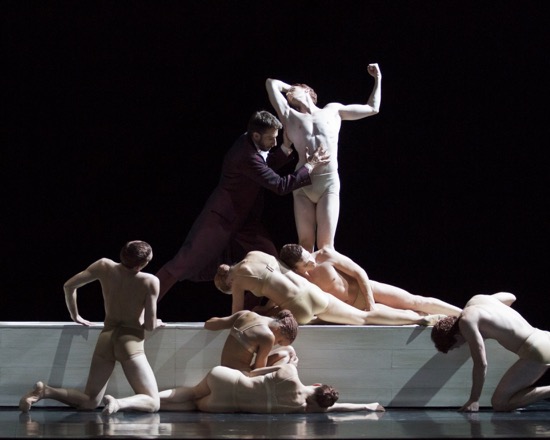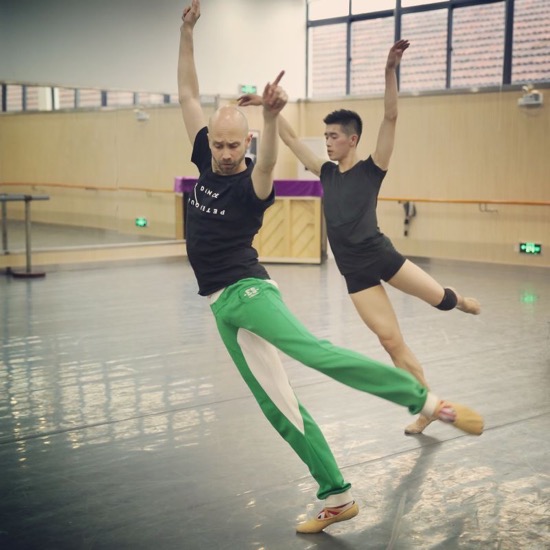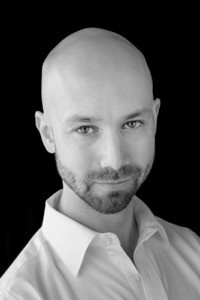
I’ve known Peter Quanz since our ballet training years at Canada’s Royal Winnipeg Ballet Professional Division. I have always admired Peter for his courage as a choreographer in taking on supreme artistic challenges and creating inventive, thought-provoking art. It has been a joy to see Peter succeed in what is an incredibly demanding and difficult career path.
I was thrilled that Peter agreed to share with 4dancers readers a bit about his life-changing adventures; his passion and drive for creating cutting edge choreography; and of course, his lovely humanity in connecting with artists across vastly different disciplines and languages. We spoke for about an hour over Skype while he was on a break from rehearsals. – Karen Musey

KM You have had an illustrious career and have explored many different avenues of work as a choreographer. What has prompted you to branch out?
PQ I’m very excited that I’ve been working as a choreographer now for over 20 years. And that has given me an incredible life, with experiences that I’d never expected I would encounter. I’m looking forward to more.
I’ve really tried to choose projects that scare me. If I don’t face a project in sheer terror with the feeling of “I’m not skilled enough for this”, then there’s an excitement that’s going to be missing.
KM You make bold choices and continually seek out opportunities to collaborate – how have these different experiences informed your perspective as a choreographer?
PQ I am currently collaborating with Montréal Danse for the creation of a new piece. To spark the creative genesis of the piece, Artistic Director, Kathy Casey proposed a question to me – “How would you make a dance if you didn’t consider the audience?”. That flummoxed me, because for me, one of my hang ups is trying to gauge what an audience is going to relate to. But if you always try to make something an audience will like, soon you will end up only sitting in the audience with them.
We started out with an initial two week rehearsal period. We spent the better part of it figuring out different ways of connecting as a group of people, when I suddenly realized that what was most interesting about this collaboration was the bond that we had as a team. The idea became how to find a way to create a social connection with the audience: essentially, a “social experiment”.

We are now building a durational production where the whole audience is animated the whole time through technology. They will be using their phone and their signals will be turned on. We are playing with people’s connection to their phones. We are seeing the phone as an extension of their bodies, as an extension of themselves. We are playing with the idea of how we can be drawn together through this immediate technology while not getting so disconnected from ourselves physically that it ceases to be dance.
KM An interesting paradox.
PQ Oh it’s been fantastic! We are finding ways of using the phones to show us our bodies and our movement in ways you can’t see in a normal performance. We are using video that is taken live, utilizing different perspectives to see parts of an image; using the settings on the phone to both create light or diminish what you see in an image. This is how we build “community” in this performance; and we risk in being brought close together with an audience in an artistic relationship, which is very exciting.
No one on our team has ever done a project like this. We are learning how to define what is happening without over defining things, because this choreography is not about steps. One of our dancers coined the phrase “aesthetic of the situation”.
I’m interested in revealing how artists think in spontaneous ways, how they make choices based on their knowledge of movement and performance; I’m curious about dancers themselves being the vulnerable material from which our experience emerges.”
The work with dancers I have in Montréal requires a sensitivity to an ever shifting relational dynamic – between the artist, their relationships to technology and the structure we have all defined as a group. In contrast with that process, I’ve gone off to work with very classical ballet companies setting choreography that is highly determinate of the music and relates closely to architectural structures in movement, which of course has to be very precise.
KM What are you currently creating with your company, Q Dance?

PQ For a Q Dance evening, it is important to me to create work that is – to reference Balanchine – “like a great meal”. There is something for everyone. There is something light and fun, there is something comedic, there is virtuosic in the use of technique, there is something contemporary that maybe tells a story or a feeling of a journey. One of the joys of that, with the eight to ten RWB dancers that I choose for Q Dance, is that I have the opportunity to invite the audience to get to know these artists in new ways.
Q Dance has a season coming up in Winnipeg, April 1st-3rd. I’m excited to invite guest choreographer and fellow RWB Alumni, Heather Myers, who has choreographed for Nederlands Dans Theatre and for many companies around the world. She works with a very different physicality than the dancers have experienced, so I’m curious to see how she integrates them into her process and what they discover. I put a tremendous effort into building a rehearsal process and environment that supports the dancers and the choreographer. Despite that is an intense, fast paced process, all of our teams must work together in a highly collaborative way.
Part of what I’m trying to do (I mean, it’s not a new thing!) is to continually question the boundaries between our communities.

In a piece with Q Dance, Pomme, I had 400 pounds of apples onstage. That work combined a dancer from Canada’s Royal Winnipeg Ballet and a dancer from Winnipeg’s Contemporary Dancers. It was the first time that dancers from both companies had been combined in a collaboration since 1982.
KM Wow.
PQ I’m involved in a process of realizing that my choices are not necessarily based on aesthetics, but they are based on ways of working, of ways of seeing. I also need to extend that perspective to everyone I’m working with, as this allows us to open and to put our humanity, our sensitivities right out on the table.
You can engage with classical idiom using contemporary abilities, sensibilities, or relationships. At the same time you can use contemporary dance to look at more classical views of hierarchy, or ways of relating to music. It’s this messy juxtaposition of aesthetics, of clashing confrontation of idioms that makes a thrilling fusion of work that is alive for today.
KM What is important to you about the people you collaborate with on your “team”?
PQ I look for strong people. A truly vulnerable, and intense artistic collaboration takes a self understanding and a strength to trust yourself that some people are uncomfortable with. I endeavor to be polite in the way that I work, but I can be confrontational. It cannot be safe, but it should be genuine and so I look for people who seem to be strong enough to manage that.
I don’t ever want to be surrounded by “yes” people. People who have vastly different aesthetics are always interesting, because that creates a fissure, a kind of crack in the viewpoint, or the perspective in the way that we work together. It’s in that friction that sometimes things spark, and I’m excited by that.
I choose team members who want to be part of a messy collaboration. The lighting designer has to discuss the choreography. If there is a musician they might be involved with placement with equipment on stage. Sometimes the dancers are really involved with developing a costume, because it shapes the way the choreography moves. For one piece we developed a tutu that was on a flexible hoop, and the shape of the costume completely informed the choreography, because the tutu bounced and folded up and moved in a way that was really interesting.
KM You have worked with dancers from many different cultural heritages and backgrounds. How do you connect with dancers, especially if there is a language barrier?

PQ I’ve had the challenges of working with dancers in Russia, Siberia, and now China. These have been opportunities for me to learn languages and to learn how to communicate with more body language. I’ve often only had a very small verbal vocabulary, and I have to find out how to guide people through a creative process when the dancers all think differently than I do, because they come from a completely different world. It is thrilling for me, because it makes me observe, and watch them to see who they are.
In 2015 I spent 5 months in China. It is extremely demanding and exhausting, to rehearse five hours a day without an interpreter in Chinese. My Chinese is not very good, but it draws us together. It makes everyone laugh when I say the wrong thing, or when they have to learn that my use of Chinese vocabulary might actually mean the opposite to what it normally means for them, but they learn that I’m trying to say. They learn my values and that I’m being vulnerable with them.
One of these projects was with the Wuxi Song & Dance Theatre, close to Shanghai. The company dancers use Chinese dance technique (not classical ballet or contemporary technique). I had to quickly learn how they moved and related to music. They had these beautiful ways of using their hands and incredible ways of moving very low to floor that are exceptionally fluid, but also is something that I’ve never encountered before.
Being able to absorb that, and infuse that language and physicality into my understanding of movement, makes a new thing. It also requires that I don’t undermine what they’ve done for years. I don’t ever try to say that what I’m doing is better than what you do. It’s different, we’re learning. We are understanding our own practices better by questioning the boundaries that separate them.
KM What has been your biggest joy this past year?
PQ I was so proud of Q Dance. This year, in our season the dancers worked with such love for each other and the work. I felt that in the process each of the dancers danced better than I’ve ever seen them dance. I was so proud of them and watching them grow is exciting. I really see that as an area of interest for me in the future; artistically. The show is not about me, the show is about us.

Peter Quanz has created ballets for some of the world’s leading ballet companies including the Mariinsky Ballet, American Ballet Theatre, the Royal Ballet (Linbury Theatre), Les Grands Ballets Canadiens de Montréal, the Royal Winnipeg Ballet, Hong Kong Ballet, the National Ballet of Cuba, and the National Ballet of Canada. He created In Tandem for the Guggenheim Museum’s Works & Process series.
Peter founded Q DANCE in 2010 to provide an opportunity to collaborate with a chamber group of exceptionally talented artists and to allow him to create his own programs. The company has close associations with the Royal Winnipeg Ballet and had a Joyce Theatre season in 2012 in New York City.
Peter Quanz has been awarded the prestigious State Medal in Literature and the Arts by President Vyacheslav Nagovitsyn of the Republic of Buryatia, Russia. The state medal recognizes a significant creation of literary or artistic work for the Republic, and acknowledges Peter’s evening of three ballets made for the Republic of Buryatia in 2011. This same programme was performed at the new Bolshoi Theatre in Moscow in October 2011.
A recipient of the Clifford E. Lee Award, Canada’s national award for young choreographers, Peter has also been supported by grants from the Canada Council for the Arts, the Chalmers Foundation, and the Judy and Henny Jurriens Choreographic Fellowship. He is a graduate of the Royal Winnipeg Ballet Professional Division. www.peterquanz.com




